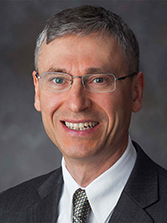Seminars
Prof. Florin Bobaru
Department of Mechanical and Materials Engineering
University of Nebraska-Lincoln
A Brief Tour of Peridynamics: predictions in brittle/ductile fracture and corrosion damage, efficient solvers, and recent controversies

ABSTRACT: Peridynamics (PD) is a very general, nonlocal reformulation of classical mechanics that allows for autonomous initiation and propagation of cracks and damage. One can say that PD unifies fracture mechanics and fragmentation theories, and eliminates the distinction between “damage” and “fracture”. In this talk I will present solutions to several problems of quasi-static and dynamic damage/failure/fracture/fragmentation using peridynamic (PD) models. A variety of material types will be considered: glass, glassy polymers (PMMA), ceramics, concrete, metals, rubber. In particular, I will focus on a number of fracture problems that have been extremely challenging to simulate with a computer before: thermally-driven fracture in glass, dynamic fracture in glass, glassy polymers, ceramics, and FRCs, quasi-static fracture in porous rock and concrete, etc.
I will explain why PD models tend to produce results similar to what is seen in experiments, when other methods fail to do so. I will also try to dispel some myths and address a recent “controversy”, initiated by Prof. Zdenek Bazant, related to PD models’ abilities of simulating failure in concrete structures.
I will next present another type of material degradation, corrosion damage, and show how our PD models for pitting corrosion, crevice and galvanic corrosion can be used to predict these dangerous processes which, when combined with fracture, can lead to catastrophic consequences.
If time permits, I will describe some recent work on fast solvers for PD models: the Fast Convolution-Based Method for PD (FCBM-PD) models of fracture (brittle/ductile) and pitting corrosion. The FCBM holds the promise of reaching time- and length-scales in predictive models of fracture and damage that were impossible to reach, efficiently, until now.
BIOGRAPHY: Florin Bobaru is a Professor and Hergenrader Distinguished Scholar of Mechanical Engineering in the Department of Mechanical and Materials Engineering at University of Nebraska-Lincoln. He received his B.S and M.S. degrees in Mathematics and Mechanics from University of Bucharest, Romania, in 1995 and 1997, respectively, and his Ph.D. degree from Cornell University in Theoretical and Applied Mechanics in 2001. He is one of the first contributors to peridynamic modeling for dynamic fracture and damage, and has introduced nonlocal modeling for diffusion problems with evolving discontinuities and corrosion damage. He was a Visiting Professor/Visiting Scholar at University of Padova, Italy (2015), Caltech (2011), Cambridge University (2008), and Sandia National Laboratory (2002-2004, 2005, 2009). He was the organizer of the first Workshop on “Nonlocal Damage and Failure: Peridynamics and Other Nonlocal Models”, sponsored by the USACM and held in San Antonio, Texas, in 2013. He was the main editor of the “Handbook of Peridynamic Modeling” (2016), an Associate Editor for “Journal of Peridynamics and Nonlocal Modeling” (Springer), and a regional editor for “International Journal of Fracture” (Springer). His paper on “Peridynamic modeling of repassivation in pitting corrosion of stainless steel”, co-authored with S. Jafarzadeh and Z. Chen and published in CORROSION journal, was awarded the 2020 CORROSION Best Paper Award by NACE. A new book on “Corrosion Damage and Corrosion-Assisted Fracture: Peridynamic Modeling and Computations” is to appear in 2022 at Elsevier.